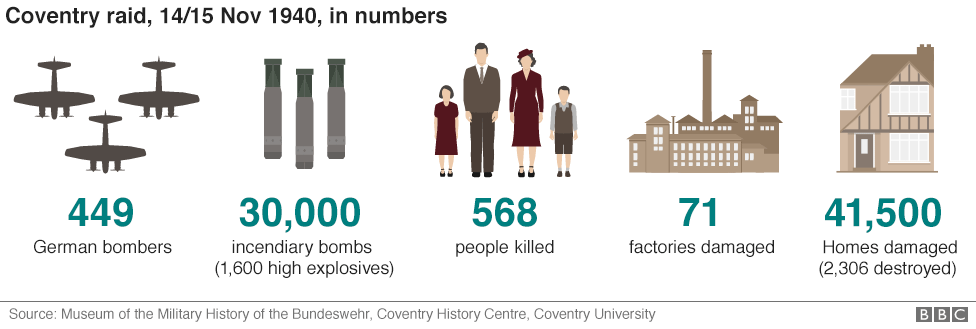City of peace and reconciliation
Coventry is recognised as a city of peace and reconciliation.
The roots of this commitment to go back to the Second World War when Coventry was partially destroyed in one of the first major air raids on England. In fact, the aid raid on Coventry on the night of 14 November 1940 was most concentrated of the German attacks. It lasted for over 10 hours and involved around 500 Luftwaffe bombers. Coventry lost its great mediaeval Cathedral, civic buildings, market places and over 40,000 homes. The official death toll from the night was 568, but there could have been many more deaths.

Coventry's response was to work towards peace and reconciliation in the post war years – a response summed up in its commitment to partnership with other cities and the work of the cathedral, in particular the work of Richard Howard (1884–1981) an Anglican priest. Howard is particularly remembered for having 'Father Forgive' inscribed in the ruined chancel of the Cathedral after the 14 November air raid (rather than 'Father Forgive them') and for later work on town twinning, beginning with Kiel, a German city which had been bombed.
The story of the bombing is told in many places. These are a couple of examples giving an overview:
- from the BBC Coventry and Warwick: The Coventry Blitz: 'Hysteria, terror and neurosis'.
- from Coventry Council Blitz pages (see within this page the link to Coventry's stories of peace and reconciliation) and there are further links to school resources provided with these pages too, including:
Primary Education Resources Secondary Education Resources Higher Education Resources
Coventry Transport Museum has a room dedicated to the Coventry Blitz Experience and (alongside the Herbert gallery) support school visits.
A further important resource is the Coventry University Centre for Trust, Peace and Social Relations. This is a large research centre carrying out research into 'many of the most critical and sensitive contemporary challenges facing society' such as conflct, forced migration and modern slavery.
Follow these links to The International Cross of Nails Schools to the Herbert Gallery and and to sub-page Sites of Remembrance.
